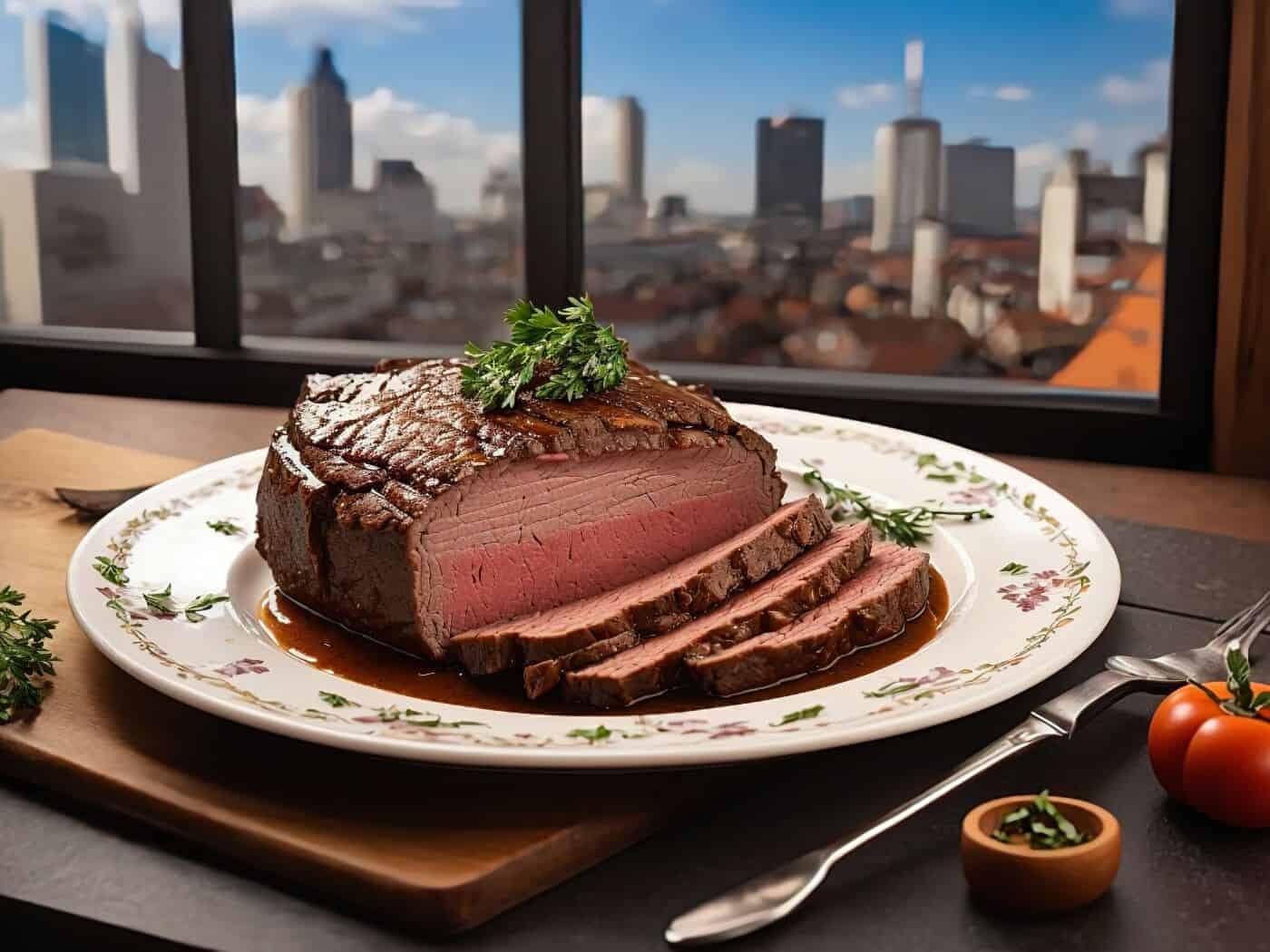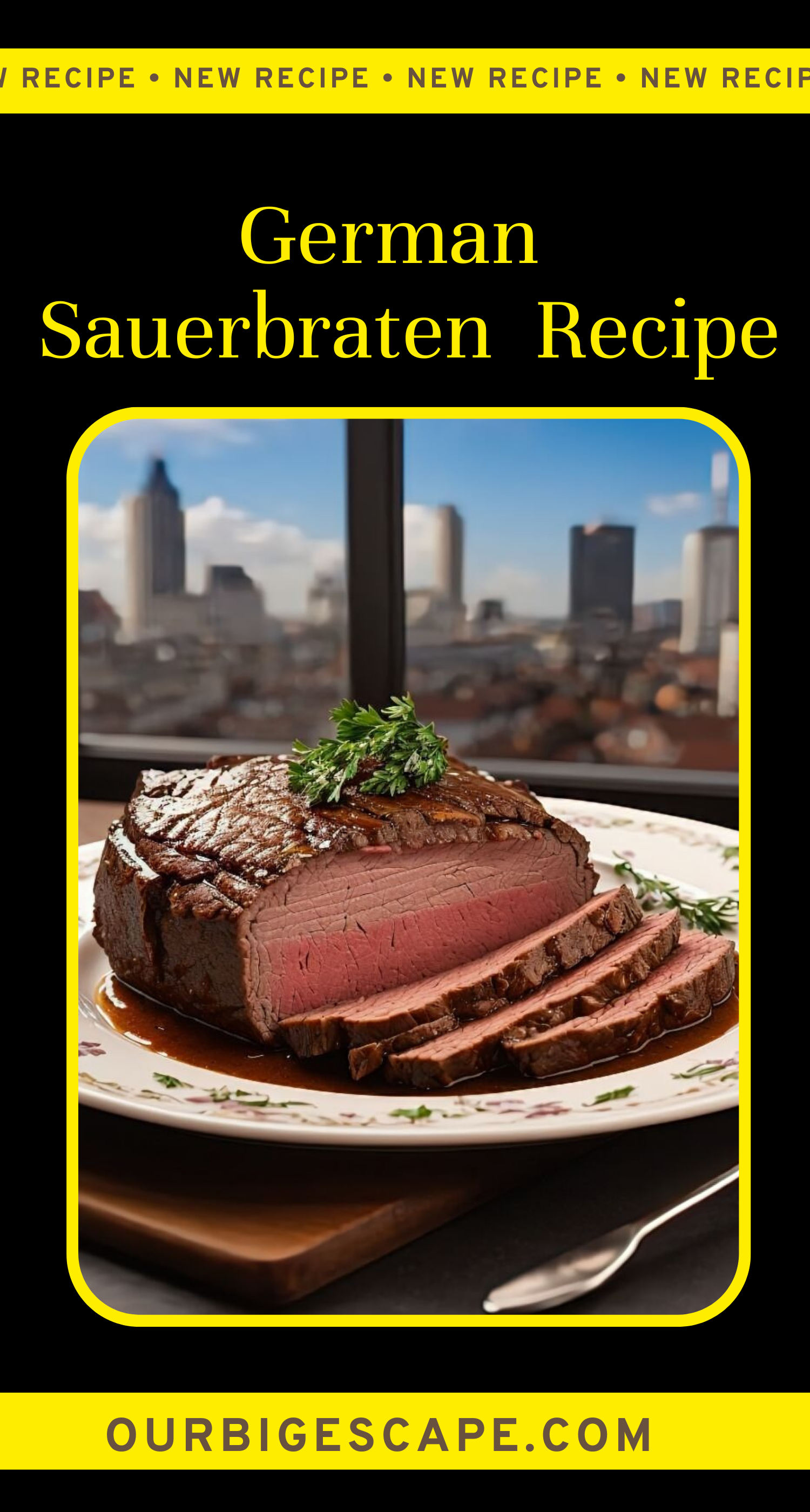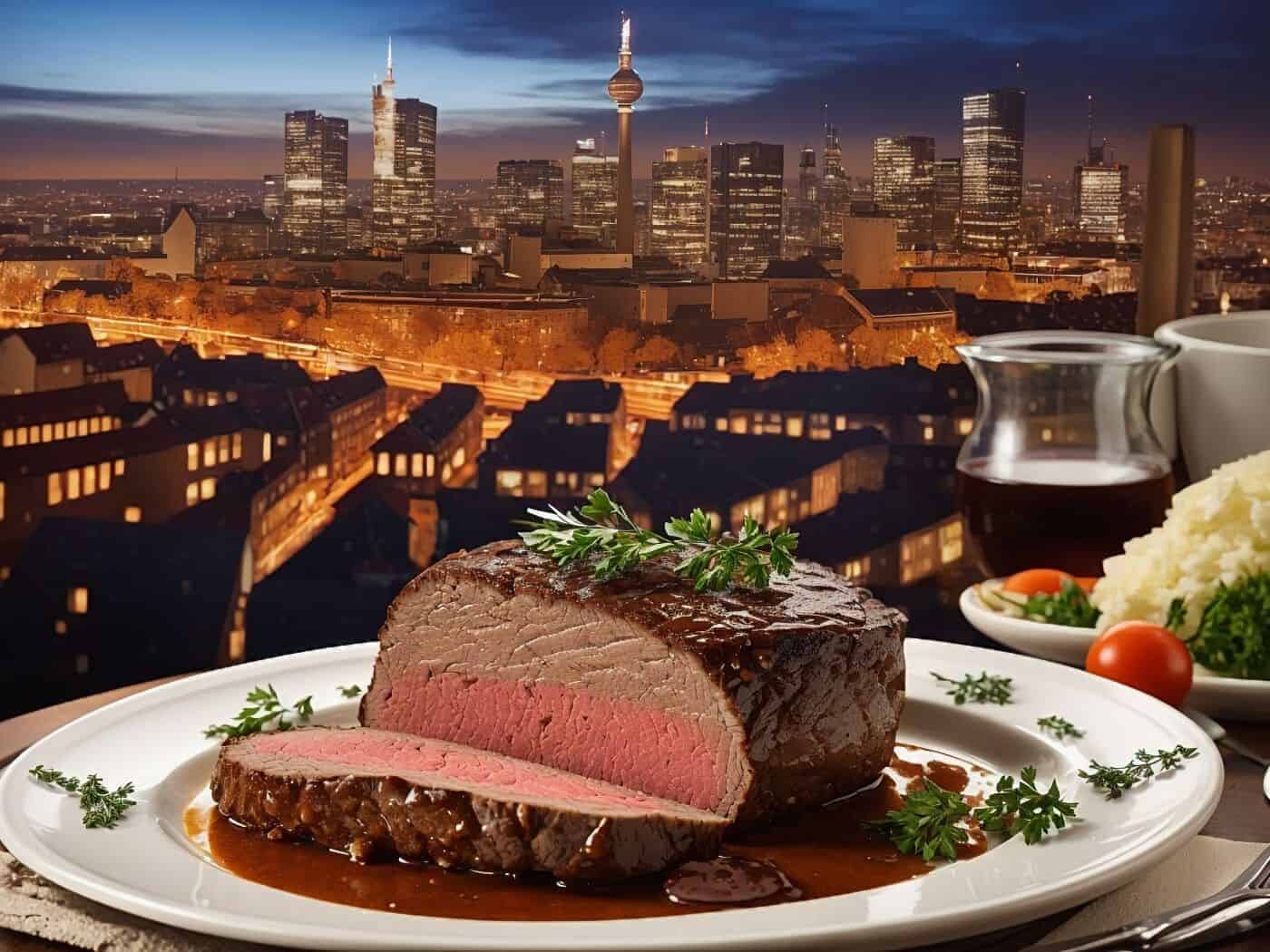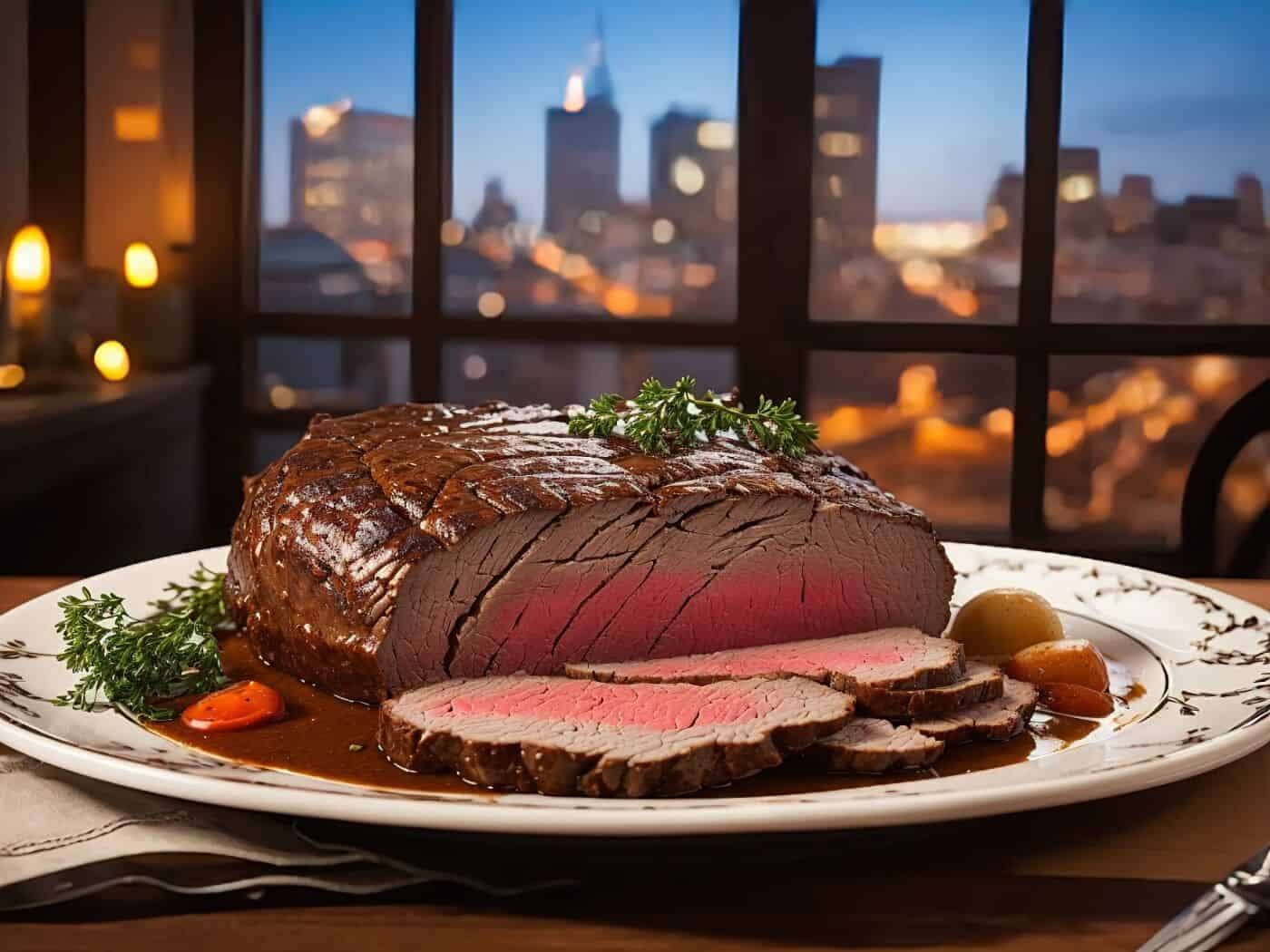
The German Sauerbraten Recipe is a traditional dish that features a flavorful and tangy roast. It typically uses a beef chuck roast or rump roast weighing around 4 pounds. The meat is often seared in a pot with vegetable oil to create a delicious crust and enhance its taste.
The recipe incorporates a variety of aromatic ingredients to infuse the dish with rich flavors. These include yellow onions, carrots, leek, garlic, thyme, rosemary, bay leaves, juniper berries, cloves, black peppercorns, and salt. Additionally, crushed gingersnap cookies are added to give the Sauerbraten its distinct taste.
Want more ideas to round-out your Brazilian Recipes Box?
A lot of great options are in these posts!
25 Easy Authentic German Food Recipes
The braising liquid used in the recipe consists of red wine, red wine vinegar, and water. These ingredients create a tangy and savory sauce that coats the meat as it simmers slowly on low heat for about 2-3 hours. This slow cooking process allows the meat to become tender and allows the flavors to meld together.
To thicken the sauce, all-purpose flour is mixed with water to form a paste, which is then added to the sauce and cooked until it thickens. Raisins are often added to the sauce for a touch of sweetness.
The German Sauerbraten can be served with traditional accompaniments such as potato dumplings or noodles. These sides complement the rich flavors of the dish and provide a satisfying meal.
You May Want to Join The World Recipes With Our Big Escape
Share your own recipes in our Facebook Group. Find recipes from all over the world. Learn more about International Cuisine and how you can surprise your family with new and exciting foods from all over the world.
For More Photos Visit Our Instagram at World Recipes Daily
In terms of potential health benefits, the German Sauerbraten Recipe offers valuable nutrients from the beef, vegetables, and spices used. The beef provides protein, iron, and B vitamins, while the vegetables contribute fiber, vitamins, and minerals. The herbs and spices used in the recipe may offer additional health benefits due to their potential antioxidant properties.

How To Make Our German Sauerbraten Recipe
Ingredients (8 Servings)
4 pounds beef chuck roast or rump roast
4 slices bacon, finely diced (optional)
2 Tablespoons vegetable oil
10 gingersnap cookies, crushed
1 tablespoon honey
2 large yellow onions, chopped
2 large carrots, diced
1 large leek, chopped, thoroughly washed and drained to remove any dirt
3 cloves garlic, minced
2 large sprigs thyme
2 small sprigs rosemary
2 bay leaves
8 juniper berries, cracked
6 whole cloves
10 whole black peppercorns, cracked
2 1/2 teaspoons salt
1 teaspoon sugar
2 1/2 cups red wine
1 cup red wine vinegar
1 1/2 cups water
4 tablespoons all-purpose flour
1/4 cup raisins
Instructions
1. Prepare the Meat:
a. Trim any excess fat from the beef chuck roast or rump roast.
b. Season the meat with salt and pepper on all sides.
2. Sear the Meat:
a. Heat 2 tablespoons of vegetable oil in a large pot over medium-high heat.
b. Add the seasoned meat to the pot and sear it on all sides until browned.
c. Remove the meat from the pot and set it aside.
3. Sauté the Aromatics:
a. In the same pot, add the chopped yellow onions, diced carrots, and chopped leek.
b. Sauté the vegetables until they are softened and lightly browned.
c. Add the minced garlic and continue to sauté for another minute.
4. Add the Spices and Flavorings:
a. Tie together the sprigs of thyme and rosemary with kitchen twine to make a bouquet garni.
b. Place the bouquet garni, bay leaves, cracked juniper berries, cloves, and cracked black peppercorns in the pot with the sautéed vegetables.
c. Stir in the crushed gingersnap cookies, honey, salt, and sugar.
5. Deglaze with Liquids:
a. Pour in the red wine, red wine vinegar, and water to deglaze the pot.
b. Scrape the bottom of the pot with a wooden spoon to loosen any browned bits.
6. Braise the Meat:
a. Return the seared meat to the pot and bring the liquid to a simmer.
b. Cover the pot and let the meat simmer over low heat for about 2-3 hours, or until it becomes tender.
c. Turn the meat occasionally during cooking to ensure it cooks evenly.
7. Thicken the Sauce:
a. Once the meat is tender, remove it from the pot and set it aside.
b. In a small bowl, whisk together the all-purpose flour with a little water to form a smooth paste.
c. Stir the flour paste into the liquid in the pot and let it cook for a few more minutes until the sauce thickens.
8. Add the Finishing Touches:
a. Return the meat to the pot and add the raisins.
b. Simmer the meat and sauce together for an additional 10-15 minutes to allow the flavors to meld.
9. Serve:
a. Slice the Sauerbraten into thin slices and place them on a serving platter.
b. Spoon some of the sauce over the meat.
c. Serve the German Sauerbraten hot with traditional accompaniments like potato dumplings or noodles.
Estimated Prep Time: 25 minutes
Estimated Cooking Time: 3 hours 25 minutes

Pots, Pan and Cooking Equipment Needed for the German Sauerbraten Recipe
Large pot for searing and braising the meat
Wooden spoon for stirring and scraping
Kitchen twine for tying the bouquet garni
Small bowl for making the flour paste
Serving platter for presenting the sliced Sauerbraten
Best Way to Store Leftovers From the the German Sauerbraten Recipe
a. Transfer the leftover Sauerbraten to an airtight container.
b. Make sure the container is large enough to hold the meat and sauce.
c. Place the container in the refrigerator to keep the leftovers fresh.
d. It is best to consume the leftovers within 3-4 days to maintain their quality.
e. Reheat the leftovers in a microwave or on the stovetop until heated through.
Tips and Tricks For Easier Creation
Marinate the meat overnight to enhance its tenderness and flavor.
Use a heavy-bottomed pot to ensure even heat distribution during cooking.
Allow the meat to rest for a few minutes before slicing to retain its juices.
For a deeper flavor, prepare the Sauerbraten a day in advance and reheat it before serving.
Consider using a slow cooker for an alternative cooking method, following the same steps.
Side Dishes and Desserts For the the German Sauerbraten Recipe
Potato dumplings
Spätzle (German egg noodles)
Braised red cabbage
Roasted Brussels sprouts
Steamed green beans
Mashed potatoes
Warm German potato salad
How To Serve the German Sauerbraten Recipe
a. Place the sliced Sauerbraten on a large serving platter.
b. Spoon some of the flavorful sauce over the meat.
c. Garnish with fresh herbs, such as chopped parsley or thyme, for added visual appeal.
d. Serve the Sauerbraten hot alongside your choice of side dishes.
e. Consider providing additional sauce in a separate gravy boat for guests to pour over their portions.
f. Enjoy the German Sauerbraten with your family and friends as a hearty and satisfying meal.
Dietary Substitution For the German Sauerbraten Recipe
1. Vegan Options for the German Sauerbraten Recipe:
a. Substitute beef chuck roast or rump roast with seitan or tempeh for a meaty texture.
b. Omit bacon or replace it with vegan bacon alternatives for smoky flavor.
c. Replace honey with maple syrup or agave nectar as a sweetener.
d. Swap vegetable oil with olive oil or coconut oil for sautéing.
e. Use vegetable broth instead of beef broth for a savory base.
f. Replace gingersnap cookies with vegan ginger cookies or gingerbread.
g. Substitute red wine with vegetable broth or non-alcoholic red wine for the braising liquid.
2. Gluten-Free Options for the German Sauerbraten Recipe:
a. Ensure all ingredients, including spices, are certified gluten-free.
b. Use gluten-free bacon or omit it altogether.
c. Confirm that gingersnap cookies are gluten-free or replace them with gluten-free ginger cookies.
d. Substitute all-purpose flour with a gluten-free flour blend or alternative such as almond flour or tapioca flour.
e. Check the labels of red wine and red wine vinegar for gluten-containing additives or use gluten-free versions.
f. Replace regular soy sauce with tamari or gluten-free soy sauce.
g. Confirm the gluten-free status of other ingredients used as sides or accompaniments.
3. Vegetarian Options for the German Sauerbraten Recipe:
a. Replace beef chuck roast or rump roast with meatless alternatives like portobello mushrooms or vegetarian beef substitutes.
b. Omit bacon or use vegetarian bacon alternatives for added smokiness.
c. Substitute honey with maple syrup or agave nectar as a sweetener.
d. Use vegetable oil for sautéing.
e. Replace beef broth with vegetable broth or mushroom broth for a savory base.
f. Omit gingersnap cookies or replace them with vegetarian ginger cookies.
g. Swap red wine with vegetable broth or non-alcoholic red wine for the braising liquid.
4. Mediterranean Diet Options for the German Sauerbraten Recipe:
a. Include lean cuts of beef, such as sirloin, as a substitute for chuck roast or rump roast.
b. Use extra virgin olive oil instead of vegetable oil for cooking.
c. Replace bacon with diced sun-dried tomatoes or olives for a savory twist.
d. Omit gingersnap cookies or substitute them with toasted bread crumbs.
e. Incorporate additional Mediterranean herbs such as oregano or basil.
f. Include diced tomatoes or tomato paste for a richer flavor.
g. Add capers or chopped olives to the dish for a tangy element.
5. Keto Diet Options for the German Sauerbraten Recipe:
a. Opt for fattier cuts of beef, such as ribeye, to meet higher fat requirements.
b. Include bacon as specified in the recipe for added fat and flavor.
c. Replace honey with a keto-friendly sweetener like erythritol or stevia.
d. Use avocado oil or ghee instead of vegetable oil.
e. Check for low-carb gingersnap cookie options or omit them altogether.
f. Choose a dry red wine with lower residual sugar content for the braising liquid.
g. Adjust vegetable ingredients to lower carbohydrate content, such as reducing carrots or leeks.
6. Heart Healthy Diet Options for the German Sauerbraten Recipe:
a. Select lean cuts of beef and trim visible fat to reduce saturated fat content.
b. Omit or reduce bacon to lower fat and sodium content.
c. Use a moderate amount of honey as a sweetener.
d. Opt for heart-healthy oils like olive oil or canola oil for cooking.
e. Use low-sodium beef broth or homemade broth to control sodium intake.
f. Choose whole grain gingersnap cookies or omit them for a lower sugar option.
g. Consider using red wine in moderation for its potential heart-healthy benefits.
7. Paleo Options for the German Sauerbraten Recipe:
a. Choose grass-fed beef as a substitute for chuck roast or rump roast.
b. Use uncured and sugar-free bacon or omit it entirely.
c. Replace honey with a natural sweetener like coconut nectar or date syrup.
d. Utilize avocado oil or coconut oil for cooking.
e. Omit gingersnap cookies or replace them with a paleo-friendly cookie alternative.
f. Select a dry red wine with no added sugars for the braising liquid.
g. Include paleo-friendly sides such as roasted vegetables or cauliflower mash.
8. Low Carb Options for the German Sauerbraten Recipe:
a. Opt for lean cuts of beef, such as eye of round, to minimize fat content.
b. Use bacon sparingly or omit it to reduce fat and calorie intake.
c. Substitute honey with a low-carb sweetener like stevia or monk fruit sweetener.
d. Choose a low-carb vegetable oil for sautéing, such as avocado oil or coconut oil.
e. Omit gingersnap cookies or replace them with a low-carb cookie alternative.
f. Consider using a dry red wine with lower residual sugar content for the braising liquid.
g. Adjust vegetable ingredients to lower carbohydrate content, such as reducing carrots or leeks.
9. Whole 30 Options for the German Sauerbraten Recipe:
a. Choose grass-fed beef as a substitute for chuck roast or rump roast.
b. Omit bacon or select sugar-free, nitrate-free bacon.
c. Replace honey with a Whole30-approved sweetener like date paste or apple puree.
d. Use compliant oils like avocado oil or coconut oil for cooking.
e. Omit gingersnap cookies or use approved spices like ginger powder.
f. Select Whole30-compliant beef broth or use homemade broth without additives.
g. Choose a dry red wine without added sulfites or sugar for the braising liquid.
10. Weight Watchers Options for the German Sauerbraten Recipe:
a. Use lean cuts of beef to reduce point values.
b. Adjust the quantity of bacon to fit within daily SmartPoints allocation.
c. Substitute honey with a sugar-free sweetener or use a smaller amount.
d. Choose a cooking spray or nonstick pan to reduce added oils.
e. Adjust the amount of gingersnap cookies to control point values.
f. Consider using a dry red wine or reduce the amount to lower SmartPoints.
g. Adapt side dish options to fit within Weight Watchers guidelines.
11. Low Fat Options for the German Sauerbraten Recipe:
a. Select lean cuts of beef, such as eye of round, to reduce fat content.
b. Omit bacon or replace it with lean turkey bacon for a lower-fat alternative.
c. Use a smaller amount of honey or omit it entirely.
d. Utilize cooking spray or nonstick pans to minimize added oils.
e. Omit gingersnap cookies or replace them with herbs and spices for flavor.
f. Use low-sodium beef broth or homemade broth to control sodium and fat content.
g. Choose a lower-alcohol red wine or use a smaller amount for the braising liquid.
12. Vegetable Variations for the German Sauerbraten Recipe:
a. Replace beef chuck roast or rump roast with thick slices of portobello mushrooms or cauliflower steaks for a vegetarian version.
b. Omit bacon or replace it with smoked tofu or tempeh for a smoky flavor.
c. Omit honey or substitute it with maple syrup or agave nectar for sweetness.
d. Use olive oil or coconut oil for sautéing the vegetables.
e. Increase the quantity of yellow onions, carrots, and leeks for added vegetable goodness.
f. Incorporate additional herbs and spices to enhance the flavors.
g. Adjust the braising liquid by using vegetable broth or a combination of vegetable broth and red wine.
Please note that the given substitutions are general suggestions, and individual dietary needs and preferences may vary. It’s always recommended to check labels, choose quality ingredients, and consult with a healthcare professional or registered dietitian for personalized advice.

FAQ About the German Sauerbraten Recipe
What is the German Sauerbraten Recipe?
The German Sauerbraten Recipe is a traditional dish that features a flavorful and tangy roast made with beef chuck roast or rump roast. It is marinated in a mixture of red wine, red wine vinegar, and various spices, then slowly cooked until tender.
What are the key ingredients in the German Sauerbraten Recipe?
The key ingredients in the German Sauerbraten Recipe include beef chuck roast or rump roast, bacon (optional), vegetable oil, gingersnap cookies, honey, yellow onions, carrots, leek, garlic, thyme, rosemary, bay leaves, juniper berries, cloves, black peppercorns, salt, sugar, red wine, red wine vinegar, water, all-purpose flour, and raisins.
How long does it take to cook the German Sauerbraten Recipe?
The estimated cooking time for the German Sauerbraten Recipe is approximately 3 hours and 25 minutes. This includes the preparation and cooking time required to achieve the tender and flavorful result.
Can the German Sauerbraten Recipe be made with substitutions?
Yes, the German Sauerbraten Recipe can be adapted based on dietary preferences or restrictions. For example, you can explore vegan options by replacing the beef with plant-based alternatives or gluten-free options by using gluten-free ingredients. It’s essential to select suitable substitutions that align with the desired dietary needs.
What are some recommended side dishes to serve with the German Sauerbraten Recipe?
Popular side dishes that pair well with the German Sauerbraten Recipe include potato dumplings, spätzle (German egg noodles), braised red cabbage, roasted Brussels sprouts, steamed green beans, mashed potatoes, and warm German potato salad. These sides complement the rich flavors of the Sauerbraten and complete the meal.
Final Thoughts
The German Sauerbraten Recipe is a flavorful and versatile dish that captivates the taste buds with its tangy and tender roast. The recipe consists of beef chuck roast or rump roast that is marinated in a mixture of red wine, red wine vinegar, and an array of aromatic spices. During the slow cooking process, the meat absorbs the rich flavors, resulting in a delectable and melt-in-your-mouth texture.
This traditional German dish offers versatility as it can be enjoyed with various sides, such as potato dumplings, spätzle (German egg noodles), or braised red cabbage. The dish is known for its balanced combination of savory and sweet elements, with the gingersnap cookies and honey providing a subtle sweetness that complements the savory flavors.
In terms of potential health benefits, the German Sauerbraten Recipe offers valuable nutrients from the beef, vegetables, and spices used. The beef provides protein, iron, and B vitamins, while the vegetables contribute fiber, vitamins, and minerals. The herbs and spices used in the recipe may offer additional health benefits due to their potential antioxidant properties.
This dish is perfect for special occasions or gatherings, impressing guests with its unique flavors and hearty nature. It can be prepared in advance, allowing the flavors to develop and intensify over time. The German Sauerbraten Recipe showcases the rich culinary heritage of Germany and is a delightful addition to any table.
German Sauerbraten Recipe
Equipment
- Large pot for searing and braising the meat
- Wooden spoon for stirring and scraping
- Kitchen twine for tying the bouquet garni
- Small bowl for making the flour paste
- Serving platter for presenting the sliced Sauerbraten
Ingredients
- 4 pounds beef chuck roast or rump roast
- 4 slices bacon finely diced (optional)
- 2 Tablespoons vegetable oil
- 10 gingersnap cookies crushed
- 1 tablespoon honey
- 2 yellow onions large -chopped
- 2 large carrots diced
- 1 leek large -chopped, thoroughly washed and drained to remove any dirt
- 3 cloves garlic minced
- 2 thyme large sprigs
- 2 rosemary small sprigs
- 2 bay leaves
- 8 juniper berries cracked
- 6 cloves whole
- 10 black peppercorns whole -cracked
- 2 1/2 teaspoons salt
- 1 teaspoon sugar
- 2 1/2 cups wine red
- 1 cup vinegar red wine
- 1 1/2 cups water
- 4 tablespoons all-purpose flour
- 1/4 cup raisins
Instructions
Prepare the Meat:
- a. Trim any excess fat from the beef chuck roast or rump roast.
- b. Season the meat with salt and pepper on all sides.
Sear the Meat:
- a. Heat 2 tablespoons of vegetable oil in a large pot over medium-high heat.
- b. Add the seasoned meat to the pot and sear it on all sides until browned.
- c. Remove the meat from the pot and set it aside.
Sauté the Aromatics:
- a. In the same pot, add the chopped yellow onions, diced carrots, and chopped leek.
- b. Sauté the vegetables until they are softened and lightly browned.
- c. Add the minced garlic and continue to sauté for another minute.
Add the Spices and Flavorings:
- a. Tie together the sprigs of thyme and rosemary with kitchen twine to make a bouquet garni.
- b. Place the bouquet garni, bay leaves, cracked juniper berries, cloves, and cracked black peppercorns in the pot with the sautéed vegetables.
- c. Stir in the crushed gingersnap cookies, honey, salt, and sugar.
Deglaze with Liquids:
- a. Pour in the red wine, red wine vinegar, and water to deglaze the pot.
- b. Scrape the bottom of the pot with a wooden spoon to loosen any browned bits.
Braise the Meat:
- a. Return the seared meat to the pot and bring the liquid to a simmer.
- b. Cover the pot and let the meat simmer over low heat for about 2-3 hours, or until it becomes tender.
- c. Turn the meat occasionally during cooking to ensure it cooks evenly.
Thicken the Sauce:
- a. Once the meat is tender, remove it from the pot and set it aside.
- b. In a small bowl, whisk together the all-purpose flour with a little water to form a smooth paste.
- c. Stir the flour paste into the liquid in the pot and let it cook for a few more minutes until the sauce thickens.
Add the Finishing Touches:
- a. Return the meat to the pot and add the raisins.
- b. Simmer the meat and sauce together for an additional 10-15 minutes to allow the flavors to meld.
Serve:
- a. Slice the Sauerbraten into thin slices and place them on a serving platter.
- b. Spoon some of the sauce over the meat.
- c. Serve the German Sauerbraten hot with traditional accompaniments like potato dumplings or noodles.

